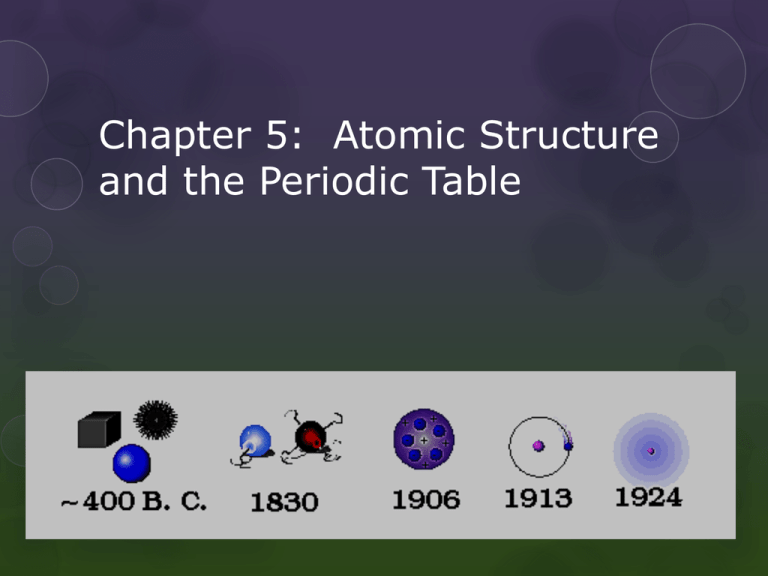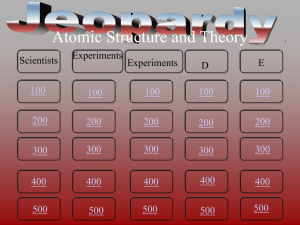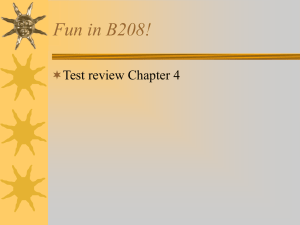Chapter 5 Atomic Structure and Periodic Table 2014
advertisement

Chapter 5: Atomic Structure and the Periodic Table Section 5.1 - Atoms Objectives – Summarize Dalton’s atomic theory Describe the size of an atom Democritus - Greece 4th century BC first proposed matter was composed of atoms. John Dalton – England (1766-1844) studied the ratios in which elements combine in chemical reactions and formulated Dalton’s atomic theory. 2 Dalton’s Atomic Theory 1. All elements are composed of tiny individual particles called atoms. 2. Atoms of the same element are identical. The atoms of any one element are different from those of any other atom. 3. Atoms of different elements can physically mix together or can chemically combine with one another in simple whole-number ratios to form compounds. 4. Chemical reactions occur when atoms are separated, joined or rearranged. Atoms of one element, however, are never changed into atoms of another element as a result of a chemical reaction. 3 Size of an Atom The atom is the smallest particle of an element that retains the properties of that element. 2.4 x 1022 atoms in a copper penny 6 x 109 humans on earth 100,000,000 (108) copper atoms lined up in a row would only measure about 1 cm (10-2 m), so that means the size of an atom is about 1x10-10m or about 1 Å (Angstrom) long. Semiconductor technology uses gate dimensions of about 450 A long and less than 100 A thick, so it is working at the atomic level. 4 TEM to see at the atomic level Where these two gold crystals meet they are joined by a complex arrangement of atoms, forming a nanobridge that accommodates their different orientations. The gold atoms are 2.3 angstroms apart. TEAM (transmission electron aberration-corrected microscope) 0.5 angstrom resolution makes it possible to distinguish individual atoms and, at the edges of the two crystals, deduce their position in three dimensions. (Credit: Image courtesy of DOE/Lawrence Berkeley National Laboratory) 5 More TEM images A TEM image of the polio virus. The polio virus is about 30 Angstroms in size. 6 Section 5.2 – Structure of the Nuclear Atom Objectives – Distinguish among protons, electrons and neutrons in terms of relative mass and charge. Describe the structure of an atom, including the location of the protons, electrons and neutrons with respect to the nucleus. 7 Thompson Experiment Electrons are negatively charged subatomic particles. J.J. Thompson discovered electrons in 1897. He passed electric current through gases at low pressure. He sealed the gases in glass tubes with metal electrodes at each end. When he connected the electrodes to an electrical source, the anode became positively charged and the cathode negatively charged. A glowing beam, called a cathode ray, traveled from the cathode to the anode. This cathode ray was composed of electrons that were attracted to the positive anode. 8 Note that the cathode ray bends upwards. What does that tell you about the nature of the charged particles that make up the cathode ray? This diagram is like the Thompson apparatus, except it has added positive and negative plates on the sides of the cathode ray tube to cause the e- beam to bend. This can be used to raster the beam across a screen, which was the technology used for television. 9 Milliken Oil Drop Experiment 1916 Milliken discovered elementary charge, e, and mass of an electron. Apparatus used force of gravity vs. electric field force to measure mass of one (or more) charge. With field off, forces are D=drag force, mg = weight. With field on, F=qE pulls oil drop upward He found every charge, q, was an integral multiple of the charge on one electron, 1.6 x 10-19 coulomb. 10 Protons Protons are the positively charged particle with the same charge as an electron. 1.6x10-19 coulomb, except the charge is + Protons have 1840x the mass of an electron Mass electron: 9.11 x 10 Mass proton: 1.67 x 10 -31 -27 kg or 9.11 x 10-28 g kg or 1.67 x 10-24 g (your book gives masses in grams on pg. 111, but kg is the SI standard unit) 11 Neutrons Neutrons have the same mass as a proton, 1.67 x 10-24 g, but have no charge, they are electrically neutral. The protons and neutrons together comprise the nucleus of an atom. The symbols for these particles are Electron e- Proton p+ Neutron no 12 Rutherford experiment In 1911, Rutherford used alpha particles 42𝐻𝑒 to bombard a very thin sheet of gold. An alpha particle is a Helium atom that has lost its two electrons and has a double positive charge, He2+ (2 protons, 2 neutrons, 0 electrons) Rutherford expected the alpha particles to pass right through the gold because it was hypothesized that the protons, neutrons and electrons were evenly spread out within the atom. 13 Rutherford, continued Rutherford expected the alpha particles to pass through with maybe only a slight deflection due to the interaction of the charge between the He2+ and the protons (repulsion of like charges). A great majority did pass through the gold foil without deflection, but a small percent bounced off the gold foil at large angles as if they had collided with a massive object, which turned out to be the large gold nucleus. Rutherford said this “was about as credible as if you had fired a 15-inch shell at a piece of tissue paper and it came back and hit you,” but it proved the existence of the nucleus. 14 Rutherford Video Rutherford’s Experiment: Nuclear Atom http://www.youtube.com/watch?v=5pZj0u_XMbc 15 Section 5.3: Distinguishing Between Atoms Objectives – Explain how the atomic number identifies each element Use the atomic number and mass number of an element to find the number of protons, neutrons and electrons Explain how isotopes differ and why the atomic masses of elements are not whole numbers Calculate the average atomic mass of an element from isotope data 16 Atomic Number The atomic number of an element is the number of protons in the nucleus of an atom of that element. The atomic number identifies an element because each element has a different number of protons. The number of electrons for a neutral atom matches the number of protons. If the atom is not electrically neutral (if it is an ion) then they do not match. Example: Na+ is missing one electron, leaving it positively charged. Cl- has an extra electron, making it negatively charged. 17 • How is the number of electrons for a neutral atom related to the atomic number of that element? • Notice anything strange in the neutron column? 18 Mass Number Mass number = # protons + # neutrons Example: Carbon has six protons and six neutrons, so it’s mass number is 12 Question: If Oxygen has an atomic number of 8, and a mass number of 16, how many neutrons does it have? Number of neutrons = mass number – atomic number. 197 79𝐴𝑢 is the notation that shows gold has a mass number of 197 and atomic number of 79. So how many neutrons does it have? 19 Practice Mass Number How many protons, electrons, neutrons? 108 47𝐴𝑔 Silver Atomic number: 47 protons Mass number: 108 108-47 = 61 so there are 61 neutrons Electrons: 47 20 Practice Mass Number 207 82𝑃𝑏 Lead Atomic number: 82 protons Mass number: 207 207-82 = 125 neutrons Electrons: 82 21 Sample Problem 5-2 Find the number of protons, neutrons and electrons in Be, Ne and Na. Element Atomic Mass Number Number Number Fill in this table. Number Find the number of protons, neutrons Number Protons Neutrons electrons and electrons in Be, Ne and Na. Be Ne Na 22 Sample Problem 5-2 Find the number of protons, neutrons and electrons in Be, Ne and Na. Element Atomic Number Mass Number Number Protons Number Neutrons Number electrons Be 4 9 4 9-4 = 5 4 Ne 10 20 10 20-10 = 10 10 Na 11 23 11 23-11 = 12 11 23 Isotopes What is an isotope? Two forms of the same element that differ in their number of neutrons. The number of protons is the same though. 24 Are these isotopes? If the blue spheres are the neutrons and the burgundy spheres are the protons, are these three items isotopes of an element? By the way, how many electrons does this atom have? The percentage values shown are the percent abundance of each isotope as it occurs in nature. 25 Sample Problem 5-3 Two isotopes of carbon are carbon-12 and carbon-13. Write the symbol for each isotope using superscripts and subscripts to represent the mass number and atomic number. 12 6𝐶 13 6𝐶 Carbon always has 6 protons. Here it can have either 6 or 7 neutrons. It has 6 electrons if neutral. 26 Atomic Mass The actual mass of a proton or neutron is very small: 1.67 x 10-24 g. However the mass of an electron is only 9.11 x 10-28g (1835 X less) So most of the mass lies in the protons and neutrons. An atomic mass unit (amu) is defined using Carbon-12. This isotope of carbon is defined as having a mass of exactly 12 amu’s (6 protons and 6 neutrons). So that means 1 amu is equal to the mass of one proton or neutron. 27 Percent abundance example Referring to Table 5.3 on page 119, Hydrogen has three isotopes Name of Isotope Symbol Natural % abundance Mass in amu “Average” atomic mass Hydrogen 1 1𝐻 99.985 1.0078 1.0079 Deuterium 2 1𝐻 0.015 2.0141 1.0079 Tritium 3 1𝐻 negligible 3.0160 1.0079 Average % weighted: (.99985 x 1.0078) + (.00015 x 2.0141) = 1.0079 28 Another weighted average mass sample Let’s say you have four atoms and you want to find their weighted average mass: 35 17𝐶𝑙 35 17𝐶𝑙 35 17𝐶𝑙 𝑎𝑣𝑒𝑟𝑎𝑔𝑒 = 𝑡𝑜𝑡𝑎𝑙 𝑝𝑟𝑜𝑡𝑜𝑛𝑠 𝑎𝑛𝑑 𝑛𝑒𝑢𝑡𝑟𝑜𝑛𝑠 4 𝑎𝑣𝑒𝑟𝑎𝑔𝑒 = 17+17+17+17+18+18+18+20 4 37 17𝐶𝑙 = 35.5 amu Or to be more simple: 𝑎𝑣𝑒𝑟𝑎𝑔𝑒 = 35+35+35+37 4 = 35.5 amu Check out the relative abundance of Chlorine-35 and -37 in the table on page 119. 29 Sample Problem 5-4 Which isotope of copper is more abundant: copper-63 or copper 65? (The atomic mass of copper is 63.546 amu) If it was 100% copper-63, the mass would be 63.0 amu. Likewise if it was copper-65, it would be 65.0 amu. If the abundances of copper-63 and copper-65 were equal, the average mass would be 64.0, right? Since the value of 63.546 is closer to 63 than to 65, it must be the case that copper-63 is a larger percent natural abundance. 30 Review The atomic mass of an element is the weighted average of the masses of its isotopes. Need to know: The number of stable isotopes The mass of each isotope The natural % abundance for each isotope 31 Section 5-4: The Periodic Table Dmitri Mendeleev (1834-1907) was the first to list the elements in a logical, systematic way. First he listed them in order by atomic mass, such that the columns had chemicals with the most similar properties. Henry Moseley (1887-1915) then determined the atomic number of the atoms in the elements. He also rearranged the table in terms of atomic number instead of atomic mass. That is the way the periodic table is arranged today. 32 See the 7 periods labeled here? The horizontal rows are called periods. There are 7 periods. 33 How many elements in period 6 ?? Did you count 32 elements? Periodic Law When elements are arranged in order of increasing atomic number, there is a periodic repetition of their physical and chemical properties. Elements that have similar chemical and physical properties are positioned in the same column of the periodic table. 34 The vertical columns are called groups or families. There are 18 groups, numbered from left to right. Group 1A elements all react explosively with water. Group 8A are the noble gases; inert gases which do not react much. 35 Group 1A to 8A elements are called representative elements because they exhibit a wide range of properties 36 First column: alkali metals Second column: alkaline earth metals 37 Columns 3 through 12 are all metals, called transition metals. The ones in columns 13-15 that are highlighted in blue are also metals. Mercury is a liquid at room temperature !!! 38 These elements on the separate rows down at the bottom are called the inner transition metals or rare-earth elements. 39 These elements colored in yellow are semi-metals or metalloids. Silicon and Germanium are semiconductors. Aluminum is not a metalloid. 40 These elements colored in red are called non-metals. They are nonlustrous and poor conductors of electricity. Some are gases at room temp, like N, O. The elements in green are called the halogens. They are also part of the non-metals category. 41 The elements in turquoise are called the noble gases, sometimes called inert gases because they are not very reactive. They are also in the non-metals category. Summary In the periodic table, the elements are organized into groups (vertical columns) and periods (horizontal rows) in order of increasing atomic number. Elements that have similar chemical properties are in the same group / column. Elements are classified as metals, nonmetals or metalloids. 42









